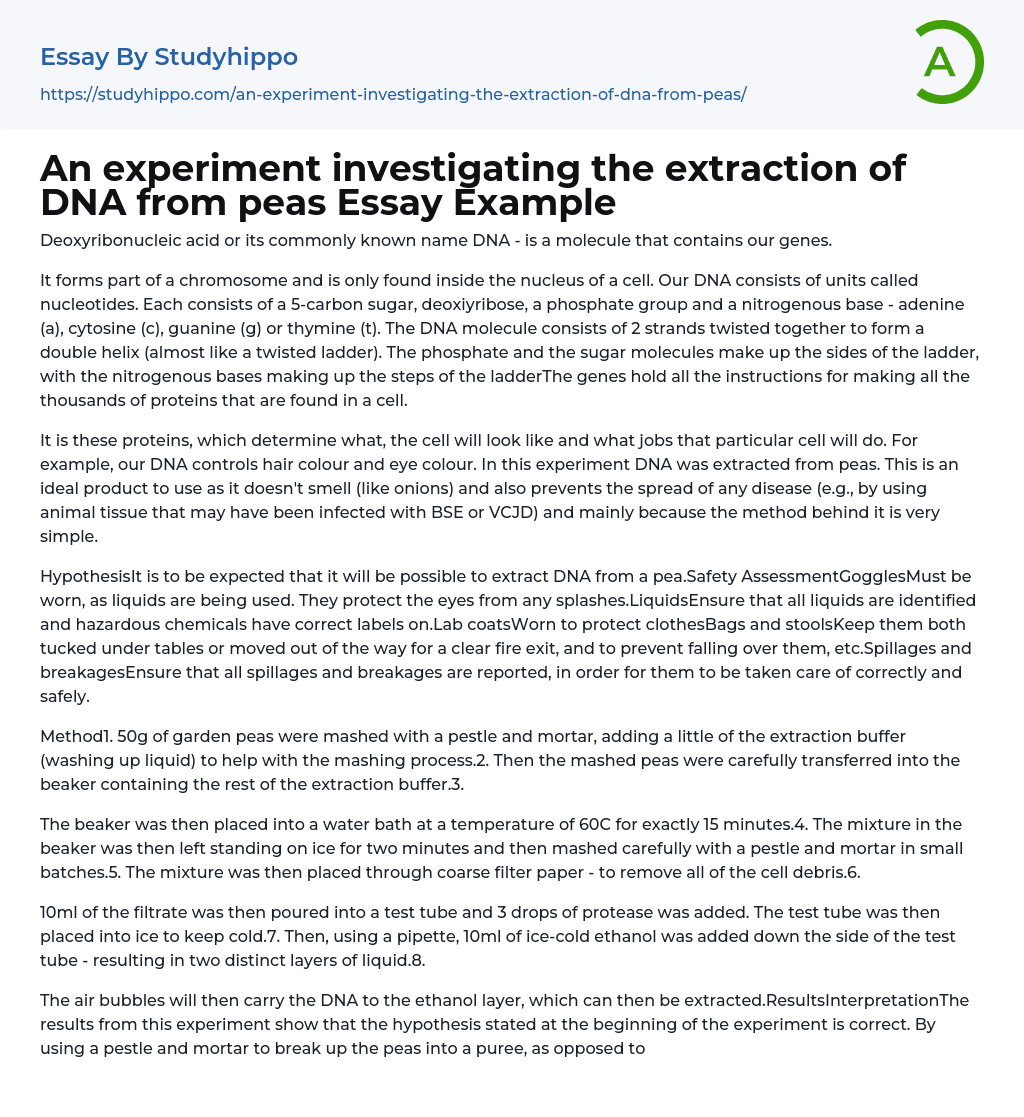

An experiment investigating the extraction of DNA from peas Essay Example
Deoxyribonucleic acid or its commonly known name DNA - is a molecule that contains our genes.
It forms part of a chromosome and is only found inside the nucleus of a cell. Our DNA consists of units called nucleotides. Each consists of a 5-carbon sugar, deoxiyribose, a phosphate group and a nitrogenous base - adenine (a), cytosine (c), guanine (g) or thymine (t). The DNA molecule consists of 2 strands twisted together to form a double helix (almost like a twisted ladder). The phosphate and the sugar molecules make up the sides of the ladder, with the nitrogenous bases making up the steps of the ladderThe genes hold all the instructions for making all the thousands of proteins that are found in a cell.
It is these proteins, which determine what, the cell will look like and what jobs tha
...t particular cell will do. For example, our DNA controls hair colour and eye colour. In this experiment DNA was extracted from peas. This is an ideal product to use as it doesn't smell (like onions) and also prevents the spread of any disease (e.g., by using animal tissue that may have been infected with BSE or VCJD) and mainly because the method behind it is very simple.
HypothesisIt is to be expected that it will be possible to extract DNA from a pea.Safety AssessmentGogglesMust be worn, as liquids are being used. They protect the eyes from any splashes.LiquidsEnsure that all liquids are identified and hazardous chemicals have correct labels on.Lab coatsWorn to protect clothesBags and stoolsKeep them both tucked under tables or moved out of the way for a clear fire exit, and to prevent falling
over them, etc.Spillages and breakagesEnsure that all spillages and breakages are reported, in order for them to be taken care of correctly and safely.
Method1. 50g of garden peas were mashed with a pestle and mortar, adding a little of the extraction buffer (washing up liquid) to help with the mashing process.2. Then the mashed peas were carefully transferred into the beaker containing the rest of the extraction buffer.3.
The beaker was then placed into a water bath at a temperature of 60C for exactly 15 minutes.4. The mixture in the beaker was then left standing on ice for two minutes and then mashed carefully with a pestle and mortar in small batches.5. The mixture was then placed through coarse filter paper - to remove all of the cell debris.6.
10ml of the filtrate was then poured into a test tube and 3 drops of protease was added. The test tube was then placed into ice to keep cold.7. Then, using a pipette, 10ml of ice-cold ethanol was added down the side of the test tube - resulting in two distinct layers of liquid.8.
The air bubbles will then carry the DNA to the ethanol layer, which can then be extracted.ResultsInterpretationThe results from this experiment show that the hypothesis stated at the beginning of the experiment is correct. By using a pestle and mortar to break up the peas into a puree, as opposed to using a blender, the DNA is broken slightly - as apposed to it being shredded. By using a detergent to help with the breaking down of the pea cell membrane - an intricate structure surrounding the membrane of phospholipids and proteins
- causing them to precipitate (separate).
The heating at 60C causes the DNA to breakdown - which is later slowed down, when cooking to prevent t he peas DNA from becoming denatured. When filtering the mixture, the filtrate now contains the DNA along with soluble proteins. By adding the ethanol down the side of the test tube, in a slow drip form, it prevents the DNA from breaking up and results in a shorter time for the strands to form. The DNA of the pea is insoluble in freezing cold ethanol and will therefore precipitate into the upper ethanol layer via air bubbles.EvaluationIf the experiment was to be repeated again, I would use a larger volume of peas, by doing so - it would result in a larger volume of DNA being extracted.
Further investigations of DNA extraction could be carried out by using blood or any other food product, providing that health and safety issues are dealt with. If the DNA was to be extracted from the test tube, it could then be stained and examined further by using a technique called X-ray crystallography, as even the most powerful microscope is unable to detect any DNA image. (www. learn.genetics.utah.edu)
- Microbiology essays
- Bacteria essays
- Cell essays
- Enzyme essays
- Photosynthesis essays
- Plant essays
- Natural Selection essays
- Protein essays
- Viruses essays
- Cell Membrane essays
- Human essays
- Stem Cell essays
- Breeding essays
- Biotechnology essays
- Cystic Fibrosis essays
- Tree essays
- Seed essays
- Coronavirus essays
- Zika Virus essays
- Agriculture essays
- Albert einstein essays
- Animals essays
- Archaeology essays
- Bear essays
- Biology essays
- Birds essays
- Butterfly essays
- Cat essays
- Charles Darwin essays
- Chemistry essays
- Dinosaur essays
- Discovery essays
- Dolphin essays
- Elephant essays
- Eli Whitney essays
- Environmental Science essays
- Evolution essays
- Fish essays
- Genetics essays
- Horse essays
- Human Evolution essays
- Isaac Newton essays
- Journal essays
- Linguistics essays
- Lion essays
- Logic essays
- Mars essays
- Methodology essays
- Mineralogy essays
- Monkey essays



